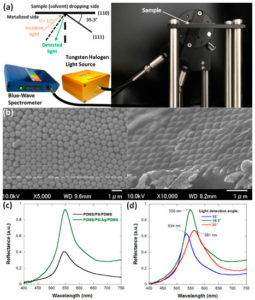Facile detection and the identification of hazardous organic solvents are essential for ensuring global safety and avoiding harm to the environment caused by industrial wastes. Here, we present a simple method for the fabrication of silver-coated monodisperse polystyrene nanoparticle photonic structures that are embedded into a polydimethylsiloxane (PDMS) matrix. These hybrid materials exhibit a strong green iridescence with a reflectance peak at 550 nm that originates from the close-packed arrangement of the nanoparticles. This reflectance peak measured under Wulff-Bragg conditions displays a 20 to 50 nm red shift when the photonic sensors are exposed to five commonly employed and highly hazardous organic solvents. These red-shifts correlate well with PDMS swelling ratios using the various solvents, which suggests that the observable color variations result from an increase in the photonic crystal lattice parameter with a similar mechanism to the color modulation of the chameleon skin. Dynamic reflectance measurements enable the possibility of clearly identifying each of the tested solvents. Furthermore, as small amounts of hazardous solvents such as tetrahydrofuran can be detected even when mixed with water, the nanostructured solvent sensors we introduce here could have a major impact on global safety measures as innovative photonic technology for easily visualizing and identifying the presence of contaminants in water.

… The reflectance measurements were carried out by placing the samples on a horizontal stage with an incident light oriented 52.3° with respect to the vertical axis (a). The light collected at an angle of 18.3° with respect to the vertical axis was analyzed using a BlueWave-VIS Spectrometer (StellarNet, Inc., Tampa, FL, USA) from 450 to 750 nm. These angles correspond to the Wulf-Bragg conditions (θ = 17°) for the close-packed nanoparticles in the (111) plane. The reflectance spectra were collected using a standard halogen lamp (StellarNet, Inc., Tampa, FL, USA, SL1 Tungsten Halogen Light Source) and normalized using the reflection spectra of Ag-covered glass substrates. All measurements were performed in the experimental room’s atmospheric conditions with temperatures of 25 °C and a relative humidity of 55%.






